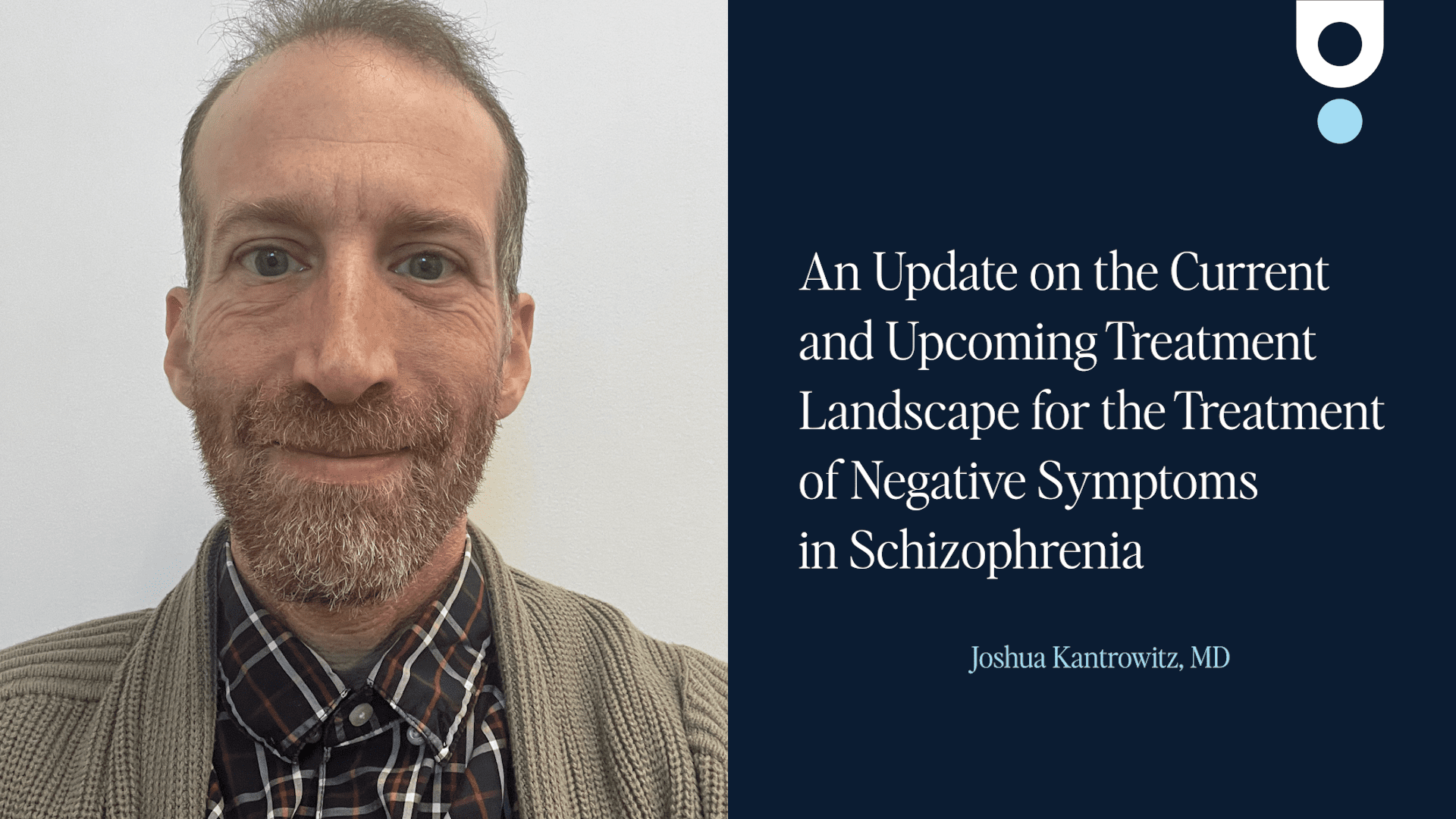Joshua Kantrowitz, MD
Associate Professor Clinical Psychiatry
Columbia University Irving Medical Center
New York, NY
Joshua Kantrowitz, MD, is an Associate Professor of Clinical Psychiatry at Columbia University where he serves as the Director of the Columbia Schizophrenia Research Center and a researcher at the New York State Psychiatric Institute/Nathan Kline Institute for Psychiatric Research. A leading expert in schizophrenia and related disorders, Dr. Kantrowitz focuses on the causes, prevention, and treatment of psychotic disorders, particularly schizophrenia. His work emphasizes NMDA receptor dysfunction, early-stage therapeutics, and auditory cognition, exploring neuroplasticity deficits and biomarker-driven treatments using neurophysiological and neuroimaging techniques.
In this video, Dr. Kantrowitz explores the potential of muscarinic acetylcholine receptor (mACHR) agonists and modulators for schizophrenia treatment, with a focus on M1 and M4 receptors. He reviews recent clinical trials, treatment efficacy, adverse events, and future research directions, highlighting Xanomeline-Trospium as the first approved mACHR modulator-based therapy for adults with schizophrenia.
This presentation is part of the Emerging Approaches in Schizophrenia Editorial Focus collection from Psychiatrist.com News. The collection focuses on the latest advances in schizophrenia treatment, with an emphasis on emerging therapies that go beyond traditional dopaminergic approaches.
Transcript
(0:00 – 0:30) Introduction to Muscarinic Agonists in Schizophrenia
Hi, I’m Dr. Joshua Kantrowitz, Associate Professor of Clinical Psychiatry at Columbia University and the New York State Psychiatric Institute. I’m here to talk about the near-term future of muscarinic agonists and modulators for schizophrenia. We’ll discuss M1, M4, and the use of both of them together.
(0:31 – 2:17) Mechanisms of M1 and M4 Receptors
The muscarinic receptors, centrally in the brain, are relatively well-preserved over the course of evolution, going back millions of years. So in order to make them drugable, which with a separate medication, it’s a little complicated to make something specific for M1, M2, M3, M4, and so on. So there’s two ways to go about this.
You could make a direct agonist, and that runs the risk of being less specific to M1 or M2 or whatnot. Another way to go is making an allosteric modulator, which you can make something a little more specific to a specific subtype of the muscarinic receptor. The other thing interesting about M1 and M4 receptors, and these are the primary receptors we want to target in schizophrenia treatment, is that they have a slightly different distribution in the brain.
This matters because they differ in the areas of the brain that they can impact. M4, over here on the right part of the slide, is found throughout the brain, frontal cortex and dorsal, but a little more prominent in the dorsal striatum, whereas M1 is a little more prominent, again, found all in the same places as M4, but a little more prominent in frontal cortex than M4 and a little more prominent in the hippocampus, which suggests that it might be more beneficial for cognition, because those are cognitive areas of the brain. Another difference between M1 and M4 circuits in the brain is that M1 is more prominent in excitatory-inhibitory circuits in the brain.
(2:18 – 3:47) Clinical Trials and Efficacy of Muscarinic Therapies
M1 is found on GABAergic interneurons, and by activating them, this can modulate the balance between excitatory and inhibition in the brain, which potentially can have a role in cognition, at least in theory. We’re going to shift a bit into some of the data from some recent trials with muscarinic agonists. This is the pooled results of the EMERGENT trials, which were the XT or Cobenfy trials, which is the only muscarinic agonist so far that’s been approved for schizophrenia treatment.
As we can see here in these slides, across these three studies, there were significant results in total symptoms of PANS, general schizophrenia symptoms across all different subtypes. That’s over in the upper left. We also saw improvements in negative symptoms and positive symptoms across the three trials.
The negative symptoms was measured in both MARTER scales, which is a little more specific for a modern conception of negative symptoms, and also using the original version of the PANSS subscale. Shifting to the potential side effects, as we know, the primary treatments for schizophrenia antipsychotics, D2 antagonists, have a lot of side effects, so nothing’s going to be side effect-free. But the muscarinic receptors have their own relatively unique set of side effects compared to these other antipsychotics.
(3:47 – 4:46) Side Effects and Safety Considerations
This is the pooled incidence of adverse events across these three trials. And we can see on the top row, constipation was more common in XT versus placebo. Same thing for dyspepsia and nausea, and especially vomiting.
It was 7.5 times more common in XT versus placebo. By contrast, agathesia, Parkinsonism, EPS, as are generally known, and body weight gain was not significantly different between XT and placebo. The thing to note about these side effects, this is based over a five-week study.
So the long-term incidence of these side effects is unknown. Skipping ahead to the cognitive results, so the XT studies were done in an acute schizophrenia population, people that were acutely exacerbated. And in a subgroup, they measured cognitive testing, both before they received the drug and after.
(4:47 – 5:41) Muscarinic Therapies and Cognitive Function
The overall results over here on the left were not significant. However, in a group that had impaired cognition at baseline, a group of 137 people, there was significant differences and a moderate effect size, suggesting that XT may be beneficial for cognition in an already impaired subgroup. The caveats to this is this was done in an acutely exacerbated population, and it’s potentially cumbersome to measure cognition in such a group.
It’s not the ideal way to do it. Ideally, and these trials will be coming, I’m assuming, is to measure cognition in a stable group, starting them on XT and seeing if they can improve those trials. Those trials will be coming, whether they’re done by the company or by independent investigators.
(5:43 – 7:10) Emerging Muscarinic-Based Treatments: Emraclidine & Neurocrine
XT was not the only muscarinic that’s been tested in schizophrenia. There’s been a published result and a publicly available result of emraclidine, which is an M4 positive allosteric modulator. Emraclidine appeared to be relatively tolerable, especially for gastrointestinal side effects, which makes sense because it’s a M4-specific positive allosteric modulator, and you won’t get off-target effects.
The phase one study, which was published, showed significant effects with a relatively small placebo effect of six-point improvement over the course of the study. The follow-up phase two were negative. The improvement with the active drug was relatively comparable to the phase one study.
However, the placebo improvement went from six points in the phase one to between 13 and 16 points improvement on the placebo group. I don’t mention this to suggest that emraclidine is something we should run out and use or whether or not it should be approved based on the results. I mention this because it is difficult for a drug to beat a placebo effect that high, and the results may have more to do with changes in the study population or the study conduct, which may have led to the placebo effect improvement versus any change in the active drug improvement.
(7:10 – 7:53) Future Directions in Muscarinic-Based Treatments
The plans for emraclidine for future studies is unknown at this time. Finally, the only other, at the time of this talk, muscarinic agent that’s been tested in schizophrenia patients and with published results is a product by Neurocrine. It’s, as opposed to the other agents, it’s a selective M4 orthostatic agonist.
Again, I don’t have the side effect results on this slide, but it seemed to be relatively tolerable according to their results. The potential caveat about this Neurocrine agent was that it was only effective in the 20 milligram dose. The other doses that were tested did not show significant improvement.
One thing to think about for the future is the placebo effect in this was relatively high already, almost 11 points. So there is less of a bar for them to pass when they go on and do their follow-up phase two, phase three study. In conclusion, the muscarinic agonists are an exciting development in schizophrenia.
We talked about M1, M4, and allosteric modulation versus agonists. Thus far, the only agent we have available for use in the clinic is XT, but there is promise for other agents in the future. Other developments I’ll be following is whether or not we can find specific improvement in cognition and whether using M1, M4 separately or both makes a difference in improvement.
Thank you for your time.
Save
Cite



